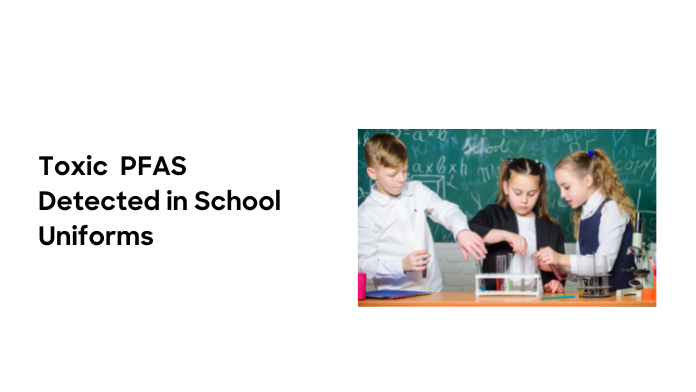A new study has discovered the presence of toxic PFAS (referred to as “forever” chemicals) in stain-resistant school uniforms commonly worn by children in Canada and the U.S.
A new study has found that school children across Canada and the United States could be exposed to per- and polyfluoroalkyl substances (PFAS) – “forever” chemicals – via their school uniforms.
According to the Environmental and Science Technology journal, which was published earlier this month, the chemical, fluorine was found in 65 percent of all school uniforms, bibs, hats, stroller covers, and swimsuits that were tested. The level of PFAS found in school uniforms was “significantly higher” than any other item of children’s clothing, as per the study.
What exactly is this PFAS chemical?
PFAS compounds have attracted increased research attention in recent years- due to their possible negative effects on human health and the environment,
“PFAS are industrial chemicals that contain multiple bonds between carbon and fluorine atoms,” says Dr. Arlene Blum, executive director of the Green Science Policy Institute.
“The strong carbon-fluorine bonds give PFAS useful chemical properties for making products oil-, stain-, and water-repellent or non-stick. But these bonds also make them extremely persistent—they never break down in the environment.’’
“Some PFAS have been associated with diverse health harms, including cancer, obesity, fertility problems, and pregnancy complications. They’ve also recently been linked to more severe COVID-19 outcomes,” adds Blum.
PFAS detected in all stain-resistant school uniforms
In the study, the research group tested nine different school uniform brands. Of all the clothing examined, uniforms made from 100 percent cotton contained the highest levels of PFAS (though cotton spandex and cotton polyester uniforms also contained the forever chemicals).
“We can screen products for total fluorine using particle-induced γ-ray emission (PIGE) spectroscopy. This gives you the surface concentrations of both PFAS, which contains fluorine bonded to carbon and inorganic fluoride salt. Inorganic fluoride is not usually found in textiles,” explains Blum.
Additional methods, such as liquid chromatography-mass spectrometry (LC-MS) or gas chromatography-mass spectrometry (GC-MS) can also be used to perform these analyses.
Why are school uniforms being treated with such chemicals?
Blum suggests it’s likely due to marketing, as organizations can declare their brand as “stain-resistant”. However, it’s likely to have “limited effectiveness in practice” according to Blum.
However, the Green Science Policy Institute has chosen to not name the brands that are included in their analyses of consumer products.
“As scientists, we do not name the brands we tested, which are a random sample of a much larger market. Plus, our results suggest that “stain-resistant” uniforms from all brands likely contain PFAS – not just from the brands we tested,” Blum says of this decision.
What can parents do to keep their children protected from PFAS chemicals?
Blum suggests that parents should check their children’s school uniforms for a “stain-resistant” label.
If such a label is present, parents should ask the school administrators to update their uniform policies and when selling new uniforms, schools should specify PFAS-free uniform options.
For already-purchased uniforms, multiple washes could reduce the amount of potentially harmful small PFAS left over from manufacturing and processing.
Used uniforms, perhaps handed down, could be a better option for children than purchasing brand new “stain-resistant” clothing.
What are we currently doing to prevent or limit PFAS exposure?
“We need to stop using the whole class of PFAS in products where they aren’t essential. Bills that phase out all PFAS in non-essential product categories (like textiles) are a good approach,” says Blum.
She adds that manufacturers should not wait for mandates to stop the unnecessary use of PFAS chemicals. To protect public health and their workers, they should stop the use of unessential PFAS in products and look for alternatives.
The Green Science Policy is contacting manufacturers to advise them on how and why they could stop the use of all PFAS in school uniforms, outdoor clothing, and other products.
You can watch the video produced by the Green Science Policy institute- to learn how you can reduce your exposure to PFAS Chemicals.
Also read: B2B eCommerce Platform Designed for Uniform Industry: Why is it gaining popularity?













